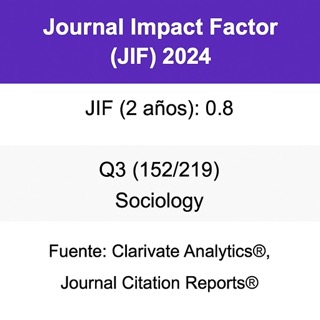Jóvenes boomerang en Andalucía; quiénes son y por qué regresan
DOI:
https://doi.org/10.22325/fes/res.2020.56Palabras clave:
Jóvenes, retorno, boomerang, emancipación familiar, AndalucíaResumen
Ciertos jóvenes regresan al hogar familiar una vez emancipados, fenómeno conocido como boomerang. El fenómeno boomerang hace referencia al retorno al hogar familiar de los jóvenes tras haber vivido un periodo de emancipación. En este artículo se pretenden analizar los factores que influyen en la decisión de retornar, los modos en que se produce y los perfiles en el caso de jóvenes andaluces que vuelven al hogar familiar. Se ha analizado una encuesta de la juventud andaluza (2017) elaborada para el Diseño del III Plan Integral de Juventud de Andalucía. Los resultados muestran que determinadas variables y situaciones vividas aumentan la probabilidad de retornar -ser mujer, la intención de seguir estudiando, haber sido víctima de violencia o consumir ciertas sustancias estupefacientes de forma habitual-, mientras que otras la disminuyen -el aumento de edad, el mayor nivel de estudios, tener un contrato fijo, tener pareja estable o tener descendencia-.
Citas
Aassve, A., Billari, F. C., Mazzuco, S. y Ongaro, F. (2002). “Leaving Home ain’t Easy. A comparative Longitudinal Analysis of ECHP Data”. Journal of European Social Policy, 12(200211), 259–276. https://doi.org/10.1177/a028430
Arundel, R. y Lennartz, C. (2017). “Returning to the Parental Home: Boomerang Moves of Younger Adults and the Welfare Regime Context”. Journal of European Social Policy, 27(3), 276–294. https://doi.org/10.1177/0958928716684315
Beaupré, P., Turcotte, P. y Milan, A. (2008). Junior Comes Back Home : Trends and Predictors of Returning to the Parental Home. Canadian Social Trends, (11), 28–34.
Bell, L., Burtless, G., Gornick, J. y Smeeding, T. M. (2007). Failure to launch: Cross-national trends in the transition to economic independence. LIS Working Paper Series No. 456.
Berngruber, A. (2013). Von Nesthockern und Boomerang Kids. Der Auszugaus dem Elternhaus alsein Schritt im Übergangvom Jugendlichen zum Erwachsenen. Der Friedrich-Alexander- Universität Erlangen-Nürnberg (en línea). http://opus4.kobv.de/opus4-fau/frontdoor/deliver/index/docId/5081/file/AnneBerngruberDissertation.pdf, último acceso 15 de abril de 2018.
Berngruber, A. (2015). “Generation boomerang” in Germany? Returning to the Parental Home in Young Adulthood”. Journal of Youth Studies, 18(10), 1274–1290. https://doi.org/10.1080/13676261.2015.1039969
Blaauboer, M. y Mulder, C. H. (2010). “Gender Differences in the Impact of Family Background on Leaving the Parental Home”. Journal of Housing and the Built Environment, 25(1), 53–71. https://doi.org/10.1007/s10901-009-9166-9
Britton, M. L. (2013). Race/Ethnicity, Attitudes, and Living With Parents During Young Adulthood. Journal of Marriage and Family, 75(4), 995–1013. https://doi.org/10.1111/ jomf.12042
Clemens, A. W. y Axelson, L. J. (1985). The Not-So-Empty-Nest: The Return of the Fledgling Adult. Family Relations, 34(2), 259. https://doi.org/10.2307/583900
Consejo de la Juventud de España.(2015). Observatoriode Emancipación nº 9. Primer trimestre de 2015 (en línea). http://www.cje.org/es/publicaciones/novedades/observatorio-de- emancipacion-n-9-primer-trimestre-2015/, último acceso 2 de septiembre de 2018.
Consejo de la Juventud de España (2017). “Observatorio de Emancipación nº 14” (primer semestre de 2017) (en línea). http://www.cje.org/es/publicaciones/novedades/obser- vatorio-emancipacion-primer-semestre-2017/, último acceso 21 de diciembre de 2019.
Eurostat (2017). “Unemployment by sex and age; annual average” (en línea). https://apps- so.eurostat.ec.europa.eu/nui/show.do?dataset=une_rt_a&lang=en, último acceso 23 de diciembre de 2019.
Furlong, A. y Cartmel, F. (1997). Young People and Social Change. Open University Press (en línea). https://eprints.gla.ac.uk/54420/, último acceso 23 de enero de 2018.
Gee, E. M., Mitchell, B. A. y Wister, A. V. (1995). Returning to the Parental “nest:” Exploring a Changing Canadian Life Course. Canadian Studies in Population, 22(2), 121–144. https://doi.org/10.25336/P6WK5T
Gentile, A. (2010). De vuelta al nido en tiempos de crisis. Los boomerang kids españoles. Revista de Estudios de Juventud, (90), 181–203. http://dialnet.unirioja.es/servlet/ extart?codigo=3651155, último acceso 10 de marzo de 2018.
Goldfarb, S. F. (2014). Who Pays for the “Boomerang Generation”? A Legal Perspective on Financial Support for Young Adults. Harvard Journal of Law & Gender, 37, 45–106. https://doi.org/10.3366/ajicl.2011.0005
Goldscheider, F. y Goldscheider, C. (1994). Leaving and Returning Home in 20th Century America. Sage Publications.
Goldscheider, F. y Goldscheider, C. (1999). The changing transition to adulthood: leaving and returning home. Sage Publications.
Hartung, B. y Sweeney, K. (1991). Why adult children return home. The Social Science Journal, 28(4), 467–480. https://doi.org/10.1016/0362-3319(91)90024-X
Huinink, J. y Konietzka, D. (2000). Leaving Parental Home in the Federal Republic of Germany and the GDR. Paper presented on the Workshop on “Leaving Home-A European Focus”. Max Planck Institute for Demographic Research Rostock.
Iacovou, M. (2010). Leaving Home: Independence, Togetherness and Income in Europe. Advances in Life Course Research, 15(4), 147–160. https://doi.org/10.1016/j.alcr.2010.10.004
Kaplan, G. (2009). Boomerang Kids: Labor Market Dynamics and Moving Back Home. Working Paper Series No. 675. https://doi.org/10.21034/wp.675
Mitchell, B. A. (2004). “Home, but not Alone: Socio-cultural and Economic Aspects of Canadian Young Adults Sharing Parental Households. Atlantis, 28(2), 115–125.
Mitchell, B. A. y Gee, E. M. (1996). “Boomerang kids” and midlife parental marital satisfaction. Family Relations, 45(4), 442–448. https://doi.org/10.2307/585174
Mitchell, B. A., Wister, A. V. y Gee, E. M. (2000). Culture and co-residence : An exploration of variation in home-returning among canadian young adults. Canadian Review of Sociology and Anthropology, 37(2), 197–222. https://doi.org/10.1111/j.1755-618X.2000.tb01264.x
Mykyta, L. y Bureau, C. U. S. (2012). Economic Downturns and the Failure to Launch: The Living Arrangements of Young Adults in the United States 1995- 2011. Milan, Italy.
Newman, K. S. (2013). The Accordion Family: Boomerang Kids, Anxious Parents, and the Private Toll of Global Competition. Boston, MA: Bacon Press.
Ongaro, F., Mazzuco, S. y Meggiolaro, S. (2009). Economic Consequences of Union Dissolution in Italy: Findings from the European Community Household Panel. Eur J Population, 25, 45–65. https://doi.org/10.1007/s10680-008-9157-7
Otters, R. V. y Hollander, J. F. (2015). Leaving Home and Boomerang Decisions: A Family Simulation Protocol. Marriage and Family Review, 51(1), 39–58. https://doi.org/10.1080/01494929.2014.963276
Paseluikho, M. A. (2000). Regrouping at the Parental Home: A grounded Theory of Female Adult Children’s Experiences of Returning Home to Live. Tesis Doctoral, The University of British Columbia.
Reher, D. S. (1998). Family Ties in Western Europe: Persistent Contrasts. Population and Development Review, 203-234. https://doi.org/10.2307/2807972
Sandberg-Thoma, S. E., Snyder, A. R. y Jang, B. J. (2015). Exiting and Returning to the Parental Home for Boomerang Kids. Journal of Marriage and Family, 77(3), 806–818. https://doi.org/10.1111/jomf.12183
Sassler, S., Ciambrone, D. y Benway, G. (2008). Are they really mama’s boys/daddy’s Girls? The Negotiation of Adulthood upon Returning to the Parental Home. Sociological Forum, 23(4), 670–698. https://doi.org/10.1111/j.1573-7861.2008.00090.x
Shanahan, M. J. (2000). Pathways to Adulthood in Changing Societies: Variability and Mechanisms in Life Course Perspective. Annual Review of Sociology, 26(1), 667–692. https://doi.org/10.1146/annurev.soc.26.1.667
Snyder, K. A. (2014). Globalization and the Changing Course of adulthood. Contemporary Sociology, 43(2), 183–186. https://doi.org/10.1177/0094306114522414c
South, S. J. y Lei, L. (2015). Failures-to-launch and Boomerang Kids: Contemporary determinants of leaving and returning to the parental home. Social Forces, 94(2), 863– 890. https://doi.org/10.1093/sf/sov064
Stone, J., Berrington, A. y Falkingham, J. (2014). Gender, Turning Points, and Boomerangs: Returning Home in Young Adulthood in Great Britain”. Demography, 51(1), 257–276. https://doi.org/10.1007/s13524-013-0247-8
Sullivan, O. (1986). Housing Movements of the Divorced and Separated. Housing Studies, 1(1), 35–48. https://doi.org/10.1080/02673038608720561
Veevers, J. E. y Mitchell, B. A. (1998). Intergenerational exchanges and perceptions of support within “boomerang kid” family environments. International Journal of Aging and Human Development, 46(2), 91–108. https://doi.org/10.2190/PVQP-A0JT-27DP-TF5C
Walther, A. (2006). Regimes of youth transitions: Choice, flexibility and security in young people’s experiences across different European contexts. Young, 14(2), 119–139. https://doi.org/10.1177/1103308806062737
Publicado
Cómo citar
Número
Sección
Licencia
Derechos de autor 2020 Revista Española de Sociología

Esta obra está bajo una licencia internacional Creative Commons Atribución-NoComercial-CompartirIgual 4.0.
Todas las publicaciones de la Revista Española de Sociología se realizarán bajo una licencia abierta Creative Commons de Reconocimiento 4.0 Internacional (CC BY 4.0). Dicha licencia establece que los autores son los poseedores de los derechos de propiedad intelectual de sus trabajos, que pueden redistribuirse a cambio de un reconocimiento adecuado. Para más información de la licencia Creative Commons, consultar aquí.
Una vez aceptado un artículo para su publicación, la Revista Española de Sociología solicitará al denominado "autor para la correspondencia" la aceptación de una licencia obligatoria Creative Commons incluida en un acuerdo o contrato de publicación.



